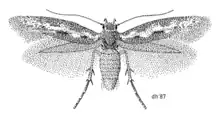| Scythris epistrota | |
|---|---|
 | |
| Lectotype | |
| Scientific classification | |
| Domain: | Eukaryota |
| Kingdom: | Animalia |
| Phylum: | Arthropoda |
| Class: | Insecta |
| Order: | Lepidoptera |
| Family: | Scythrididae |
| Genus: | Scythris |
| Species: | S. epistrota |
| Binomial name | |
| Scythris epistrota (Meyrick, 1889) | |
| Synonyms[1] | |
| |
Scythris epistrota is a species of moth in the family Scythrididae first described by Edward Meyrick in 1889.[2] It is endemic to New Zealand and has been observed in the South Island. The larvae have been found on species of New Zealand broom and they pupate within an irregularly shaped, dense, silken cocoon. Adults are day flying and are on the wing from November until February.
Taxonomy
This species was first described by Edward Meyrick in 1889 and named Butalis epistrota.[3][1] Meyrick used specimens collected on the Port Hills in Christchurch and at Mount Arthur in January when first describing this species.[3] In 1928 George Hudson discussed this species in his book The Butterflies and Moths of New Zealand.[4] However John S. Dugdale pointed out that both the description and illustration given in that book by Hudson related to an undescribed species from Mount Arthur.[1] In 1930, thinking he was describing a new species, Alfred Philpott named this species Elachista laucstris.[5] Meyrick synonymised this name with S. epistrota in 1931.[6] Hudson confirmed this synonymy in 1939.[7] The male lectotype is held at the Natural History Museum, London.[1]
Description

Meyrick described this species as follows:
♂ ♀. 10–11mm. Head, palpi, antennae, thorax, abdomen, and legs rather dark grey, slightly bronzy-tinged, generally somewhat sprinkled with whitish; antennal ciliations ½; abdomen in female whitish beneath. Forewings lanceolate; rather dark bronzy-grey, more or less densely strewn with whitish scales; in paler specimens there are indications of two very ill-defined inwardly oblique darker streaks on anterior half, more distinctly spotted with darker on fold, and two less perceptible outwardly oblique streaks on posterior half; an obscure round dark fuscous dot in disc at ¾: cilia pale bronzy-grey. Hindwings ⅔ grey; cilia 2, pale bronzy-grey.[3]
Distribution
This species is endemic to New Zealand.[8] Other than the type locality of the Port Hills near Christchurch, this species has been observed in Kaikōura,[7] near Lake Pukaki,[1] in Twizel,[9] and in Queenstown.[10]
Behaviour
The larvae emerge from their eggs during October to December.[11] The larvae pupate in an irregularly shaped, dense, silken cocoon.[7][9] The adults of this species are day flying and are on the wing from November until February.[9][12][13] This species has been collected via hand collecting and Malaise trapping.[14]
Habitat and hosts

This species inhabits open grass country and shrubland.[4] Hudson stated in his book A supplement to the butterflies and moths of New Zealand that the larvae of S. epistrota on species of Carmichaelia at Clarence Bridge, near Kaikoura, in November.[7] This larval host was confirmed by Brian Patrick in 1994.[13]
References
- 1 2 3 4 5 John Stewart Dugdale (23 September 1988). "Lepidoptera - annotated catalogue, and keys to family-group taxa". Fauna of New Zealand. Department of Scientific and Industrial Research. 14: 110. doi:10.7931/J2/FNZ.14. ISSN 0111-5383. Wikidata Q45083134.
- ↑ Gordon, Dennis P., ed. (2010). New Zealand inventory of biodiversity: Kingdom animalia : chaetognatha, ecdysozoa, ichnofossils. Vol. 2. p. 463. ISBN 978-1-877257-93-3. OCLC 973607714. OL 25288394M. Wikidata Q45922947.
- 1 2 3 Edward Meyrick (May 1889). "Descriptions of New Zealand Micro-Lepidoptera". Transactions and Proceedings of the New Zealand Institute. 21: 161. ISSN 1176-6158. Wikidata Q56065895.
- 1 2 George Vernon Hudson (1928), The butterflies and moths of New Zealand, Illustrator: George Hudson, Wellington: Ferguson and Osborn Limited, p. 320, LCCN 88133764, OCLC 25449322, Wikidata Q58593286
- ↑ Alfred Philpott (1930). "Descriptions of Lepidoptera in the Canterbury Museum". Records of the Canterbury Museum. 3: 247–250. ISSN 0370-3878. Wikidata Q117474618.
- ↑ Edward Meyrick (1931). "Notes on New Zealand Lepidoptera". Records of the Canterbury Museum. 3: 367–369. ISSN 0370-3878. Wikidata Q117474623.
- 1 2 3 4 George Vernon Hudson (1939), A supplement to the butterflies and moths of New Zealand, Illustrator: George Hudson, Wellington: Ferguson and Osborn Limited, p. 459, OCLC 9742724, Wikidata Q109420935
- ↑ "Scythris epistrota (Meyrick, 1889)". www.nzor.org.nz. Retrieved 2022-05-05.
- 1 2 3 B. H. Patrick (January 1992). "Supplement to the Lepidoptera of the Mackenzie Country with recommendations on their conservation" (PDF). New Zealand Entomologist. 15 (1): 48–58. doi:10.1080/00779962.1992.9722629. ISSN 0077-9962. Wikidata Q57483707. Archived from the original (PDF) on 9 February 2013.
- ↑ Alfred Philpott (1917). "A list of the Lepidoptera of Otago". Transactions and Proceedings of the New Zealand Institute. 49: 195–238. ISSN 1176-6158. Wikidata Q63958657.
- ↑ Brian Patrick (1 December 2014). "Conservation status of five data deficient moth taxa: Epichorista lindsayi, "Cnephasia" paterna, Stathmopoda endotherma, Gymnobathra ambigua and Scythris "stripe"". The Wētā. 48: 15–34. ISSN 0111-7696. Wikidata Q105343576.
- ↑ "Scythris epistrota (Meyrick, 1889)". www.gbif.org. Retrieved 2023-04-09.
- 1 2 Brian H. Patrick (1994), Coastal butterflies and moths of Wellington and South Wairarapa. (PDF), Wikidata Q110426707, archived from the original (PDF) on 13 December 2021
- ↑ Tara J. Murray (15 September 2019). Invertebrates of the Tasman River Plain: Characteristics of the invertebrate community and an analysis of sampling methods for biodiversity assessment (PDF) (Report). New Zealand: Department of Conservation. p. 58. Retrieved 9 April 2023.